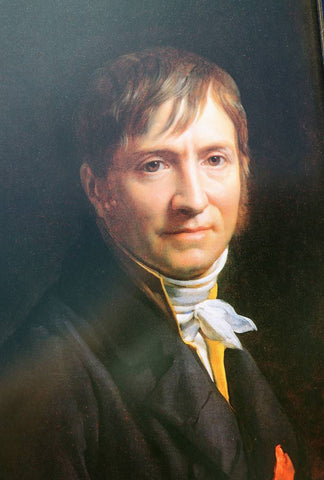Pierre-Joseph Redouté
Pierre-Joseph Redouté, born on July 10, 1759, in Saint-Hubert, Belgium, was a renowned French botanical artist. He is widely regarded as one of the greatest floral painters in history and is often referred to as the "Raphael of Flowers." Redouté's artistic work, characterized by its exquisite detail, delicate rendering of botanical specimens, and graceful compositions, left an enduring impact on the world of botanical illustration.
Redouté began his artistic training in his hometown of Saint-Hubert, studying under the painter and printmaker Charles Joseph Flipart. In 1782, he moved to Paris, where his talent quickly gained recognition. He found patronage among the French aristocracy and became a favoured artist at the court of Marie Antoinette.
Redouté's breakthrough came when he was appointed as a draftsman and painter to Empress Joséphine Bonaparte, wife of Napoleon Bonaparte. This association provided him with access to an extensive collection of exotic plants at the Château de Malmaison, where he had the opportunity to study and paint a wide variety of botanical specimens.

Pierre-Joseph Redouté, 10 July 1759 – 19 June 1840
One of Redouté's most significant accomplishments is his series of books titled "Les Liliacées" (The Lilies) and "Les Roses" (The Roses). These publications cemented his reputation as a master botanical illustrator. "Les Liliacées," published between 1802 and 1816, featured over 400 hand-colored plates depicting lily-like plants. "Les Roses," published between 1817 and 1824, contained nearly 170 plates showcasing different rose varieties. Redouté's illustrations in these books were highly regarded for their precision, accuracy, and exquisite attention to detail, capturing the delicate nuances of each flower.
Redouté's illustrations were primarily created using watercolors, a medium he mastered to perfection. His meticulous brushwork and subtle shading techniques allowed him to capture the ephemeral beauty of flowers with remarkable realism. His compositions were carefully arranged, often featuring a single flower as the central focus, surrounded by leaves, stems, and other botanical elements.
Redouté's artistry extended beyond his botanical illustrations. He also produced illustrations for various other publications, including works on fruit, cacti, and ornamental plants. Additionally, he collaborated with eminent botanists and scientists of his time, such as Charles Louis L'Héritier de Brutelle and Aimé Bonpland, contributing to the scientific documentation of plants through his art.
Redouté's impact on the art world was profound and enduring. His work influenced subsequent generations of botanical artists, and his style became synonymous with the golden age of botanical illustration. His prints remain highly sought after by collectors and continue to be admired for their beauty and scientific accuracy.
In summary, Pierre-Joseph Redouté's life was marked by his extraordinary talent as a botanical artist. His meticulous attention to detail, delicate brushwork, and masterful compositions elevated the genre of botanical illustration to new heights. Redouté's legacy endures, and his works continue to inspire artists and nature enthusiasts alike, reminding us of the timeless beauty found in the world of plants and flowers.
